|
Sony's PlayStation Portable has been an interesting test-bed for the DragonBall franchise over the years. Gameplay from the Budokai series was tweaked and near-perfected via the two Shin Budokai games (which one could argue carried over quite nicely into Infinite World on the PS2 and Burst Limit on the PS3/360), but that was under the direction of prior developer Dimps. There was a little bit of trading back and forth on "main games" for a couple years, but Spike has become the de facto developer in recent times. The Sparking! series evolved from the PS2 and Wii up into Raging Blast on the current generation of consoles, but so far that has been it — no side projects to speak of.
No side projects until now, that is. DragonBall: TAG VS was officially unveiled for the PSP in April 2010, and advertisements immediately hyped up the two-on-two battle system, something not seen since the PS1 and Saturn days. Over the next five-to-six months, the standard deluge of character scans and announcements would surface, much in the same way that its console brother, Raging Blast 2, was experiencing.
Would that be enough, though? Would the two-on-two shtick (and international name change to Tenkaichi Tag Team, a clear grab at the poorly-worded Budokai Tenkaichi series' name changes made even more apparent by its new logo font) be all it took?
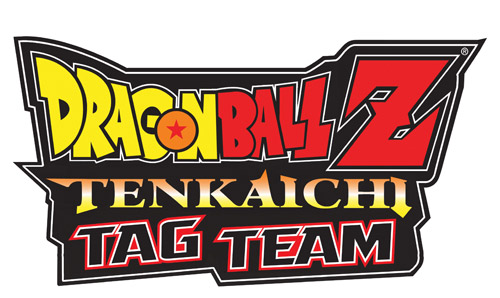
Review of this game was made possible through a copy provided by Namco-Bandai. If you are interested in contributing to the site, please visit our "Donate" page or contact us directly.

Review By: Mike LaBrie (VegettoEX)
So how about that there video game...?
I hesitate to say it has been a "slow" year for DragonBall video games in 2010: we had DragonBall DS / Origins 2 earlier this year, Raging Blast 2 coming just a couple weeks after TAG VS / Tenkaichi Tag Team, and all the usual grumblings out of DragonBall Online on the other side of the world. Perhaps 2010 being a "standard" year is a more appropriate description? — no cross-over games, no new developers, and no truly fresh series lines (2009 had the Wii beat-'em-up game to spice things up a bit in that regard).
With that in mind, I was ready for the second DragonBall game of the year. It has been a pretty heavy portable RPG year for me between Pokemon: SoulSilver and Dragon Quest IX on the Nintendo DS, so it was also a nice change-up to break out the PSP and get my fight on.
It may go without saying at this point that my first course of action with any DragonBall video game is to change the language track over to Japanese. After installing game data to the memory stick to save on loading time later on (a process that took about ten minutes), I was off to the options area to select those voices! Unfortunately (and I already had this spoiled for me before receiving the game), there is no language option to be found in this release. It is a bit confounding: while certainly under the direction of a prior distributor (Atari, in this case), the two Shin Budokai games on PSP each had dual-language selections, and even Namco-Bandai's own distribution of Attack of the Saiyans on the Nintendo DS last year was Japanese-voices-only, albeit limited to attack names and noises. There is a significant amount of voice acting in this game, and to not have the Japanese track selectable as an option in this day and age is pretty heart-breaking.
That being said, the cast presented in Tenkaichi Tag Team is FUNimation's current cast for DragonBall (Z) Kai, which should set everyone at ease at least a little bit. More on that later.
This particular game's main single player mode is one called "Dragon Walker". At a quick glance, it appears very similar to the "overworld" map from something like Budokai 3 back on the PlayStation 2. You take control of a pre-determined character (occasionally selecting a companion who fights alongside you in battles), fly from location to location, engage in fights, find hidden items, check in on towns, and so on and so forth.
Where this mode differs from previous outings is in its incessant and monotonous battles against random henchman. While entirely avoidable either by simply flying right past them or using the "Square" button to defend, they are present for the sole purpose of extending what would otherwise be a story arc consisting of: (1) Raditz appears, (2) fight Raditz, (3) next story arc. Countless Saibaiman litter the Saiyan arc, a swarm of Freeza Soldiers (specifically of the "A" variety) litter the Freeza arc, Cell Jrs. litter the jinzôningen arc right from the start of it, and... well, Freeza Soldiers (OK, "Alien Soldiers") return for the Buu arc.
At the very least, it explains why Freeza Soldier was announced as a playable character. On the other hand, it is just awful. Thankfully, as noted, all of these henchman fights can be avoided if you fly straight toward the actual opponent, who stands still waiting for you in almost every instance (right after being introduced directly in front of you and subsequently transported across the length of the entire map for you to fly across — it will certainly leave you scratching your head more than once). You will miss out on collecting extra "D-points" and the occasional wacky dialogue from characters as they speak with NPCs in towns, but it will probably cut your play time in half and lower your frustration a great deal. You truly understand just how awful it is when the Buu story arc begins and seventy bazillion "Alien Soldiers" all crash down to Earth for you to beat up.
Dragon Walker mode has a few quirks which are barely mentioned in a quick tutorial upon first starting the mode, and not detailed at all in the instruction manual. Pressing the "Square" button will unleash a type of defensive move which is different per each character: Gohan creates a buffer around him, Vegeta fires a blast, Goku teleports away, etc. This can be used to avoid close encounters with the random grunts, but does not otherwise affect the game in any way. Pressing "Triangle" charges your ki, and it appears that if your power engulfs any surrounding enemies you will engage in battle with them... but I will be damned if it has any real purpose. To offset the quirks are screen shots from the anime underneath narration every so often; thankfully, most of the shots are from "good animation days".
After making my way through approximately half of the overall Dragon Walker mode, I decided to check out what kind of tutorials the game had to offer. Previous outings were meticulous about teaching you each and every technique available in the game, and Tenkaichi Tag Team is no exception... with one exception: the "tutorial" mode is but a series of text boxes. Unlike other games, you are not given a task to complete such as performing a specific type of combo, rush, or defensive maneuver. After discussing this on our podcast preview of the game, I am still conflicted — I would have loved to have gone through an extensive tutorial to learn the ins-and-outs of advanced play, but the onus remains on me to discover how to play and implement those techniques on my own, regardless of whether the game hands it to me on a plate. At the end of the day, though, the same basic play styles you have been adapting over the last four years will still carry through in Tenkaichi Tag Team.
Beyond the standard story mode and versus play, Tenkaichi Tag Team does offer another single-player category entitled "Battle Selection". This category houses the expected "Survival" and "Score Ranking" modes, but also contains a fun section called "Battle 100". The player is presented with a series of grids similar to a go or checker board where each dot contains a match that must be completed with a special objective in mind. By completing one of these special battles, that particular dot is "won". By completing subsequent missions, a line is drawn between each of these dots. Lines can be multiplied across each other (for example, a square of four dots creates six lines between each other in the end) to multiply the amount of "D-points" won. It is rather clever, and provides a bit of incentive to keep playing each of the short battles one after another. Were this to be integrated into the game's larger story mode, it may have been a fantastic first rollout of the Sparking!-influenced series on the PSP. Unfortunately, it is a second-thought shoved aside to a sub-menu.
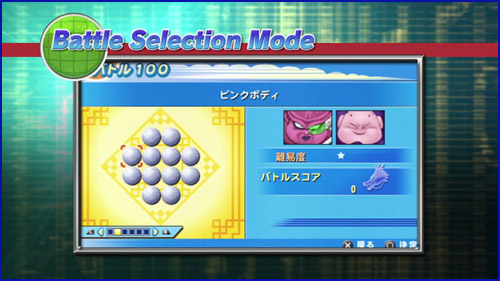
Unlocking characters and stages is simply a matter of completing Dragon Walker mode — one run-through of the mode, without going back to any extra levels you unlock along the way and without starting up some of the new "What If?" scenarios, leaves only eight question marks on the character select screen. Only a few character unlocks switch up the formula — to unlock Gogeta as a playable character, you select to use him instead of Vegetto during a fight against Buu while replaying a previously-completed Dragon Walker stage. Other than this, play on and you are good to go with the entire roster of seventy characters, which includes various transformations. Note that, like prior games, characters such as Vegetto and Super Vegetto count as two separate entries in the roster, and while selectable from the same icon on the character select screen, the player can either go with the base form of the character and transform mid-battle, or select the transformed version right there.
The character models used in Tenkaichi Tag Team are not as much of a step down from their console brethren as one might think. They are a little more blocky, sure, but they are detailed, colorful, and honestly feel like the characters... at least until they are in motion.
Far be it from me to understand the intricacies of PSP development, but something funky has gone on with the art direction and eventual display. It would make sense that the game was developed with larger assets than could ultimately be displayed within the PSP's resolution, as would be suggested by screen shots released officially through Namco-Bandai. Whatever the process was, you will certainly notice the slight glaze of fuzz surrounding each of the character models during fights. It is not particularly distracting, but it is different enough from what we have seen before on the PSP (even from cel-shaded games) that you will take note of it.
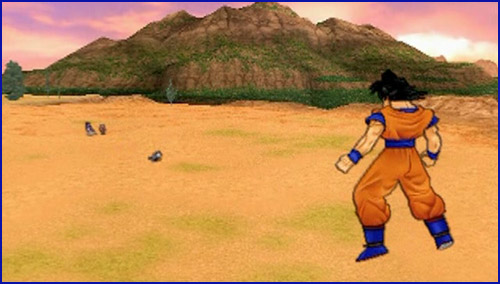
Overall, the game looks rather fantastic, with my only qualification being those character models. Yet again, Spike seems to be unable to move beyond these "puppets" of characters — they simply have no life. To be fair, the downscale to the PSP and Dragon Walker mode's chibi versions leaves little room for these characters to emote, but the same lifeless floating animations are mirrored across all characters. Time after time I managed to get my floating synced up with my teammate, and the two of them hovering next to each other frame-for-frame in combination together was rather creepy.
During battle, however, everything is up to the standards Spike has set in recent years. You will encounter no slow down at all, minus at the end of larger special attacks like the Genki-Dama. I noticed the occasional background stage glitch in the lower left of the screen where the flooring would pop out to black, but rushing in toward the opponent immediately fixed the missing textures. The background stages, overall, are rather sparse despite their colorful and detailed nature.
The new "HUD" for Tenkaichi Tag Team is a combination of older versions plus its own unique adaptations for the PSP's smaller screen. The "ring" system from Raging Blast is gone in favor of a standard horizontal life bar, supplemented by a more-traditional ki meter with five individual bars that can be powered up. Also returning is the ability to power-up your ki meter into the red to unleash stronger attacks and string together combos that would otherwise peter out (such as an endless barrage of punches).
What about the fact that you will often be playing two-on-two battles? Does the screen have room for all of that information, and would you be able to parse it mid-battle anyway? The answer to all of these questions is a resounding "No!", and Spike recognized that. While your teammate's life bar gets shrunken down to the lower left corner, a target-esque "ring" for opponents is shifted to the background with that character, rather than taking up prime real estate in the forefront. Attached to this ring is the opponent's life bar. It is a genius move, and a showcase that Spike honestly does pay close attention to these types of display elements.
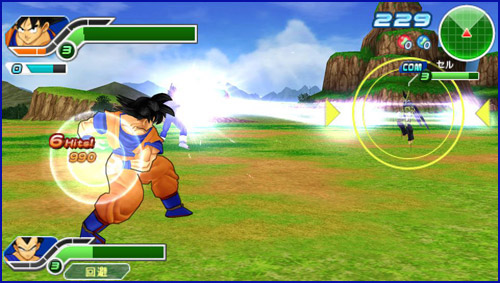
This targeted ring also acts as your lock-on in the franchise's typical free-reign battle stages, and switching targeted opponents is as simple as pressing the right shoulder button.
The menus of Tenkaichi Tag Team are a wonderful toss back to the PlayStation 2 generation of games with animated 2D drawings. Goku flying, Gohan training with the sword, Bulma tinkering away with some machines... they are all lovely backdrops, and bring a modern-yet-old-school feeling to the game.
As mentioned earlier, the voices in the American version of the game solely consist of FUNimation's English cast, with no selectable Japanese option (despite the entire Japanese voice cast being listed in the ending credits roll). Thankfully, all DragonBall (Z) Kai cast changes are carried over in full, including Monica Rial as Bulma, Colleen Clinkenbeard as Gohan, Doc Morgan as the narrator, and the spectacular Chris Ayres as Freeza. It is, quite honestly, the very first time I have been able to enjoy an English-dubbed Freeza arc in DragonBall Z video game history, an element that added fuel to the fire of playing the entire Sparking! series imported a few years back (the addition of early Japanese release dates sure did not hurt, either).
Related to the FUNimation English dub of the show is the expected batch of name changes present throughout the game. While the Kaiô-Ken pronunciation is thankfully corrected a la the Kai dub, attack name changes have reverted to prior incarnations (such as the abysmal "Special Beam Cannon"). It is almost as if the game is a NickToons-edit... which makes sense considering their intended audience.
That being said, voice performances (while excellent overall) are kept to a minimum. Characters will occasionally begin speaking aloud their lines during the "overworld map" areas of Dragon Walker mode, only to suddenly stop talking two or three lines in. The majority of conversation is held back for final "boss" encounters mid-fight — for example, during Super Saiyan Goku's final fight against Freeza. Spoken dialogue in Dragon Walker mode always seems delayed by a second or two from when it pops on screen in text, and even signature attack cries during battles are called out long after the attack is actually fired... and this is with the optional game install.
The music takes a back seat and never makes any attempt to shine through. What few tracks there are tend to drone on in the background with little range to them. The simply "so-so" music pairs unfortunately well with those equally-sparse background stages, leaving the characters themselves as your sole point of attention. For a portable game, maybe that is for the best...?
It is worth noting for those of you playing with headphones that the explosion sound effect used on the Dragon Walker map screen is overwhelmingly more loud than anything else in the game. Consider yourself warned.
It would be impossible to talk about a DragonBall fighting game without noting the distinct differences between what makes a "Budokai" game different from a "Sparking!" game. The Sparking! series (of which Tenkaichi Tag Team is an off-shot of) has been accurately described as more of a "DBZ-simulator" than a traditional "fighting game"... which is not necessarily an entirely fair statement. While it is technically two (in this case, up to four) characters battling each other with life bars, special attacks, and super moves, Tenkaichi Tag Team goes in its own direction with a camera back away from the shoulder of the playable character, who is free to fly nearly anywhere on the stage (within its imposed limits) and either engage in close-range melee combat, or mid- to long-range attacks with ki blasts.
Tenkaichi Tag Team carries over the same basic control layout as Raging Blast last year, which includes the shift of character control from the d-pad to the analogue nub. The lack of the extra two shoulder buttons creates a few awkward situations, though, where "Select" acts as your transformation button, and up and down on the d-pad act as your hovering up and down in the air... which means you have to stop controlling your character momentarily to move your character in a different way.
There is an alternate control scheme which switches up the hovering to a combination of the "X" button (the normal dash button) plus the right shoulder button, which in turn results in the down button on the d-pad being changed to swapping which opponent you target on.
Actual character control in battle is mostly responsive and as you would expect from a developer with four games of this ilk under their belt. There are quirks to the game play that you will need to get used to (such as being unable to cancel out of certain melee combos if you press the square button too many times; get used to punching at air every so often), but beyond that, it is relatively easy to pick up, get accustomed to, and start whacking away on a baddie. The Sparking!-style of L+Triangle for super moves makes sense (including pressing an extra button combination for additional damage), pressing the right shoulder button switches which opponent you are focused on, and so on and so forth.
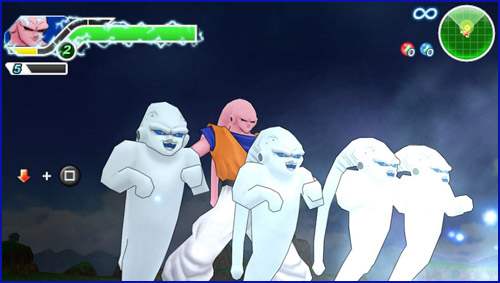
Despite the ingenious targeting system, I found that "locking on" to my opponent was not as obvious and simple as it should be. I had many instances of flying circles around my opponent while trying to dash directly into them, only to have them very slowly hover in the opposite direction, which in turn sent me flying in giant counter-clockwise circles instead of clockwise-circles around them.
We have spoken about it at length, and it really just brings the discussion back around to what your preferred "type" of game is (something that only you as the player can answer for yourself), but a control scheme of this type with this many characters simply perpetuates the idea that all characters in the game play exactly the same. If you can always melee away with a face button and then follow it up by pressing L+Triangle for a super move, what incentive do you have to learn multiple characters, never mind all 70 of them? As always with Spike's games, there are minor differences among characters... but perhaps due to it being a portable game and roughly based on prior incarnations, these differences feel as vague and superficial as ever; your strategy with Tenshinhan will be roughly the same as your strategy with Broli.
The challenge level of the game is another head-scratcher. Up through the Cell story arc, you will be able to punch-punch-punch, kick into the air, punch-punch-punch, toss a ki blast and you are done. Wash, rinse, repeat. Every single opponent. No special moves needed. No vanishing counters. No real strategy. On the off-chance that you look away from the screen for the two or three minutes necessary for an opponent to deal enough damage to "beat" you, a senzu will revive you and give you ample opportunity to take them out in "revenge". It was only when Dabra began teaming up with "Alien Soldier" did I feel that they were even remotely collaborating with each other in their assault on me, and occasionally even blocking an attack of mine. Changing the opponent's difficulty is only available in non-Dragon Walker modes, leaving any advanced strategy formulations to standard versus battles (against either the computer or another human player, the latter in ad-hoc mode only).
Thankfully, camera position is not an issue as it was with last year's Raging Blast on the consoles. Whether it is due to the smaller screen, position of the characters and their relation to each other on the screen... whatever it is, it works. You will occasionally find yourself stuck behind a cliff, but the game will do the standard make-everything-translucent technique so you can place yourself. Like prior PSP games in the franchise, you can also slightly adjust the positioning of the camera, though only between three settings (each one slightly more overhead and further away than the last).
Character customization is achieved through spending "D-points" (obtained during single-player modes) on "D-items" and character slot expansions. Rather than enabling new attacks or techniques, these customizations are statistic enhancements only: doubling attack power, recovering health, less ki consumption, etc. Minor visual enhancements are available such as changing the color of your character's aura, but that is the extent of your tweaking ability. It is very similar to the capsule system in the Budokai series, but with even less customization.
Each character can be expanded from two up to six slots in their "Ability Type" customization area by spending an enormous amount of D-points. By playing through Dragon Walker mode normally, I was able to expand Goku up to his maximum of six slots and quite a few other characters a few more, as well. The "Tag Type" and "Intellect Type" areas, while not expandable, can be equipped with additional enhancement items and play styles. "Tag Type" items customize characters specifically with regard to their partners and team actions, while "Intellect Type" balances attributes depending on the "type" of character you wish to incorporate (for example, "Goku Type" is a balance of attack and defense). Customized characters can also be used in Dragon Walker mode, though by default a normal version of the character without any items attached will be used. Pausing the game brings up a sub-menu allowing access to the customization screen for three slots per character. You are unable to spend D-points to expand slots with Dragon Walker mode, but you can apply and take away items at will from each of the three customized versions of a character.
Once you have played through Dragon Walker mode (including the extra stages unlocked within it along the way), the "Battle Selection" single-player area will be your sole focus of any extra play time. There is no museum-type mode to view character information, samples, etc.
Loading up the demo for Tenkaichi Tag Team (available via the PlayStation Store, unlike the full game itself, which will not be available for digital distribution; sorry PSP Go owners) grants immediate access to the "Union Heal" item in the full game. This item allows its user to recover health during "Union Status" (related to a gauge that allows you to execute combination attacks with a partner). It is nothing particularly special, but is a nice addition for super-fans, none-the-less.
There is a halfway-fun game hidden inside Tenkaichi Tag Team. It really is in there somewhere. The overall experience is unfortunately dragged down by its repetitive and abhorrently-boring fights in Dragon Walker mode. There are only so many times a player can fight a Saibaiman or Freeza Soldier before wanting to rip their hair out. With a few clever additions pulled from Budokai 2 and Budokai 3's story modes, a little mix-up in character interactions could have gone a long way.
Control and game play has been refined from the Sparking! series with the expected changes in the current Raging Blast series, including the analogue nub controlling character movements. The lack of additional buttons on the PSP hinder some advanced motions like flying up and down, but this may make the game slightly more accessible than its console predecessors.
The seventy-strong character roster is impressive for a handheld outing, even if some of them are toss-away inclusions solely for the purpose of extending Dragon Walker mode (Saibaiman, Freeza/Alien Solder, Cell Jr.). The graphics hold up even with their slight glaze of fuzz, and while no Japanese voice option is available, the updated Kai English cast alleviates what could have been a painful experience in several areas.
With multiplayer not being as huge a part of the PSP community in North America as it is in Japan, your tag team experience will likely be limited. Unfortunately, joining up with a CPU-controlled teammate just is not the same as teaming up with a friend, and you will often feel like there are two completely separate fights going on which just happen to be taking place on the same background stage. Team-based play can be a huge part of Tenkaichi Tag Team, and it would not be a surprise to see it possibly make its way to future console incarnations of the game, assuming it could be done and still guarantee the 60 frames-per-second Spike can genuinely claim with the Raging Blast games.
Are you a fan of the Sparking!-style games? Do you own a PSP other than the PSP Go? Do you not mind primarily playing by yourself? If you have the patience of a saint to make your way through Dragon Walker mode, you will likely find a good deal of fun in Tenkaichi Tag Team. The rest of us may want to hold off a little bit and see if the game can be refined a little more in any possible sequels.
Tenkaichi Tag Team was developed by Spike and published by Namco-Bandai, released in North America on 19 October 2010. MSRP $39.99. One run-through of "Dragon Walker" default stages completed in roughly 10 hours. All characters unlocked. 42% of D-Items acquired. Dabbled in several more hours of additional "Dragon Walker" stages and "Battle Collection" modes. Clicked the "X" button on all training text boxes for fun. Battled against Freeza Soldier roughly 291 times.
Tenkaichi Team Team is available nationwide at most game retailers.
|